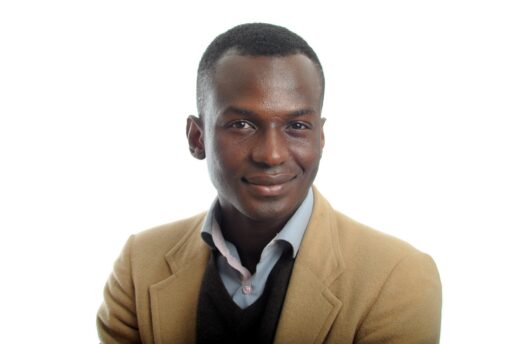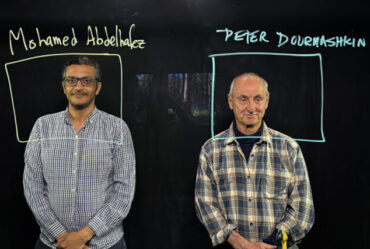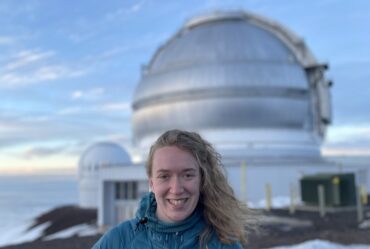
3 Questions: Ibrahim Cissé on using physics to decipher biology
A physicist employs super-resolution microscopy to peer inside living cells and witness never-before-seen phenomena.
How do cells use physics to carry out biological processes? Biophysicist Ibrahim Cissé explores this fundamental question in his interdisciplinary laboratory, leveraging super-resolution microscopy to probe the properties of living matter. As a postdoc in 2013, he discovered that RNA polymerase II, a critical protein in gene expression, forms fleeting (“transient”) clusters with similar molecules in order to transcribe DNA into RNA. He joined the Department of Physics in 2014, and was recently granted tenure and a joint appointment in biology. He sat down to discuss how his physics training led him to rewrite the textbook on biology.
Q: How does your work revise conventional models describing how RNA polymerases carry out their cellular duties?
A: My interest in biology has always been curiosity-driven. As a physicist reading biology textbooks, I thought that transcription — the process by which DNA is made into RNA — was fully understood. It’s so basic, and the textbooks write about it with such confidence. Come to find out, most of what we know about the cell nucleus, where gene expression starts, comes from people studying these processes outside the cell, inside a test tube. I started to wonder: Do we actually know how they work in a living cell?
The textbook models say that when a specific gene is being activated, RNA polymerase and dozens of other molecules are recruited to the DNA to begin transcription. If you don’t look closely enough, the polymerases appear to be uniformly distributed and acting randomly throughout the nucleus. However, my single-molecule and “super-resolution” microscopy methods allowed me to see something different when I looked inside live cells: polymerase clusters, which are very dynamic. In the mid-’90s, people had observed similar clusters in so-called “fixed” cells that were chemically frozen. But these findings were dismissed as possible artifacts of the fixation procedure. However, when we saw these same protein clusters in living cells that were not treated with harsh chemicals, it suggested that the textbook explanation may be incomplete.
Q: How has your background in physics given you a unique perspective on the mechanics of living cells?
A: When I arrived at the University of Illinois at Urbana-Champaign to begin my PhD in physics, I hadn’t enrolled in a biology class since high school. I was really taken with the interdisciplinary work of one physics professor, Taekjip Ha, who became my PhD mentor. He had developed single-molecule fluorescence resonance energy transfer techniques, to study with unprecedented sensitivity when two biomolecules are close to each other and monitor the distance between them in real time.
Taekjip graciously accepted me into his lab despite my limited biology background, and I never looked back. His work mirrored my interest in condensed matter physics, but the material we were looking at wasn’t from the inanimate world, it was living matter.
Between 2006 and 2008, as I was working on my PhD, super-resolution microscopy really took off from the single-molecule microscopes I used in grad school. It was a natural progression, in my mind, to learn cell biology during my postdoc fellowship at École Normale Supérieure in Paris, and to try to visualize weak and transient interactions directly in living cells using single-molecule and super-resolution imaging. You could now pinpoint molecules with nanometer accuracy; you could “turn on” and “off” molecules to observe them individually and ensure there was no overlap between those that were side-by-side.
Thanks to these new techniques, we saw clusters of RNA polymerases in living cells for the first time during my postdoc, and I pushed the technique further to reveal the cluster dynamics. But the fact that you had to turn individual molecules on and off made it really hard to see these clusters assembling or disassembling. I didn’t want to trade temporal resolution for spatial resolution. So I came up with an approach called Time-Correlated Photoactivated Localization Microscopy (tcPALM). It allowed us to measure the lifetimes of these ephemeral polymerase clusters, and we found that they last just a few seconds.
Once I arrived at MIT, we wanted to test whether the clusters could be fleeting but still biologically relevant. We pushed a dual-color super-resolution technique where we correlated the clusters with gene activity. With RNA live-imaging experts at Howard Hughes Medical Institute’s Janelia Research Campus, Brian English and Tim Lionnet, and my postdoc, Wonki Cho, we found that roughly 80 to 100 polymerases form a cluster on a gene where transcription is about to start. Although the cluster is only there for a few seconds, that’s enough time to load a handful of polymerases and generate “bursts” of RNA transcription. In fact, there was a linear correlation between the clusters’ transient dynamics and the number of messenger RNAs made in each burst.
Q: What is it like to be a physicist working with biologists?
A: Even though I joined MIT as a physics hire, I was lucky enough to get lab space in Building 68 alongside amazing biologists. They were the perfect people to talk to about my crazy ideas. And it turned out that renowned researchers like Rick Young and Phil Sharp actually had similar theories. They had genomic evidence for clusters of gene regulators, which they call “super enhancers,” that we all thought could relate to what my lab was seeing. That’s led to hours of exciting discussions between our labs, and has evolved into one of my most rewarding collaborations — and revealed that clusters associate as tiny transcriptional condensates with properties of liquid droplets.
Now, students and postdocs in my lab are wondering about the clusters’ functions and mechanisms of action, and whether protein clustering extends beyond transcription. For instance, clustering could explain some aspects of neurodegeneration. One perplexing idea that came out of this work is that perhaps it gets harder for our cells to clear protein condensates as we age, leading to Parkinson’s, Alzheimer’s, and other diseases. It’s becoming clearer that physics may be just as important as biology for understanding how cells work. The physics of how condensates and droplets form in the inanimate world is increasingly helpful in determining how living cells can evolve to regulate the same process for specific biological functions like transcription. Nature uses physics in much more elaborate ways than we initially anticipated.


